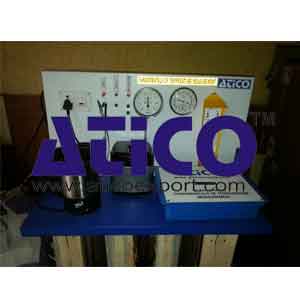Scada System Fundamentals of Temperature Measurement
Categories: Mechanical Lab Equipment ManufacturerScada System Fundamentals of Temperature Measurement Technical Description Scada System Fundamentals of Temperature Measurement:- Recording temperature is one of the basic tasks in process and manufac...
Product
Description
Scada System Fundamentals of Temperature Measurement
Technical Description
Scada System Fundamentals of Temperature Measurement:- Recording temperature is one of the basic tasks in process and manufacturing automation. Electronic temperature sensors are the most widely used in automation applications but conventional thermometer types are still widely applied in many areas. The experimentation set-up covers the full range of temperature measurement methods. As well as non-electrical measuring methods, such as gas- and liquid-filled thermometers and bimetallic thermometers, all typical electronic measuring methods are covered in the experiments. The electronically measured temperatures are displayed directly on programmable digital displays. A temperature-proportionate output voltage signal (0 - 10V) is accessible from lab jacks, enabling temperature characteristics to be recorded with, for example, a plotter. A digital multimeter with precision resistors is used to calibrate the electrical measuring devices. Various heat sources or storage units (immersion heater, vacuum flask and laboratory heater) permit relevant temperature ranges to be achieved for the sensors being tested. A plastic casing houses the sensors, cables, temperature measuring strips and immersion heater. The well-structured instructional material sets out the technological fundamentals and provides a step-by-step guide through the measurements and experiments.quick overview :
Scada System Fundamentals of Temperature Measurement
Technical Description
Scada System Fundamentals of Temperature Measurement:- Recording temperature is one of the basic tasks in process and manufacturing automation. Electronic temperature sensors are the most widely used in automation applications but conventional thermometer types are still widely applied in many areas. The experimentation set-up covers the full range of temperature measurement methods. As well as non-electrical measuring methods, such as gas- and liquid-filled thermometers and bimetallic thermometers, all typical electronic measuring methods are covered in the experiments. The electronically measured temperatures are displayed directly on programmable digital displays. A temperature-proportionate output voltage signal (0 - 10V) is accessible from lab jacks, enabling temperature characteristics to be recorded with, for example, a plotter. A digital multimeter with precision resistors is used to calibrate the electrical measuring devices. Various heat sources or storage units (immersion heater, vacuum flask and laboratory heater) permit relevant temperature ranges to be achieved for the sensors being tested. A plastic casing houses the sensors, cables, temperature measuring strips and immersion heater. The well-structured instructional material sets out the technological fundamentals and provides a step-by-step guide through the measurements and experiments.Product
Reviews
add Review
reviews
No Review Yet.








Product
Reviews
add Review
reviews
No Review Yet.